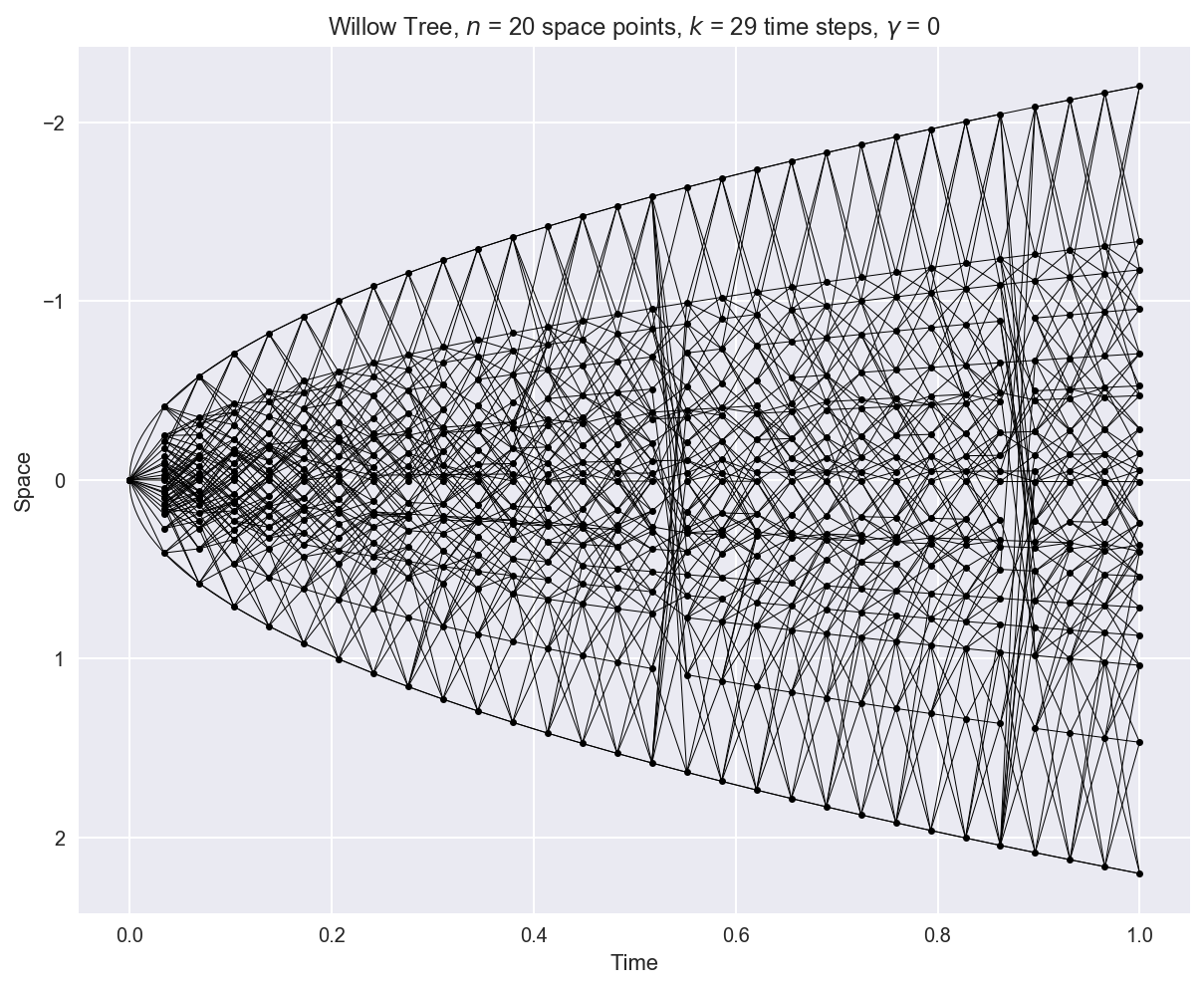willowtree is an open source Python implementation of Michael Curran's derivatives pricing model of the same name.
Curran, M. (2001): Willow Power: Optimizing Derivative Pricing Trees
The willow tree is a highly efficient, recombining lattice designed for fast and accurate pricing of derivative contracts. It models the standard Brownian motion directly, by means of a discrete time Markov chain, and the resulting estimate can serve as the basis for more complex processes, such as the geometric Brownian motion.
The lattice has two distinctive features:
-
it expands as the square root of time, in accordance with the Brownian motion and unlike the binomial model, which grows linearly in time. It opens quite fast at the beginning, covering a high-probability region neglected by standard trees, and slowly later on, being constrained within a set confidence region of the normal marginal distribution. This aspect both prevents the waste of time and computational resources on the tails of the distribution, areas with little impact on the definition of the current price of the security, and avoids the arbitrary practice of pruning the tree, namely, disregarding branches, along with their offsprings, located in low probability regions;
-
it has a constant number of nodes per time step. With time, this number grows linearly, and not quadratically, as it does in the binomial model.
These features increase the efficiency of the lattice, because they force the paths to travel across a smaller structure squeezed in the body of the desired density, and allow for a fast convergence to the true, unknown price distribution.
Being a proxy for the standard Brownian motion, willowtree can:
- help price a wide array of European and American derivative contracts;
- be considerably faster than other lattices, such as the binomial and trinomial, especially in higher dimensions: once a set of transition matrices is generated, it can be stored and becomes available for future use;
- serve as building block for more complex processes (e.g. the geometric Brownian motion) and models (e.g. stochastic volatility, interest rate), of particular relevance in finance, engineering, and physics.
A detailed history of the model, as well as the mathematical theory behind it, are available in the companion handbook.
willowtree requires Python 3.5+, and is built on top of the following modules:
- NumPy: v. 1.13+
- SciPy: v. 0.19+
- Matplotlib: v. 2.0+
- Seaborn: v. 0.8+
The source code is currently hosted on GitHub at: https://github.com/federicomariamassari/willowtree.
Either clone or download the git repository. To clone the repository, on either Terminal (macOS) or Command Prompt (Windows) enter the folder inside which you want the repository to be, possibly changing directory with cd <desired path>, and execute:
$ git clone https://github.com/federicomariamassari/willowtree.gitWhen the process is over, navigate through folder willowtree using cd willowtree and run:
$ python3 setup.py installor, if only Python 3 is present on your system, simply:
$ python setup.py installThen, within a Python environment, e.g. IDLE or Jupyter Notebook, execute:
import willowtreeor use wt as alias:
import willowtree as wtFinally, call any of its modules, e.g. sampling, as either: willowtree.sampling or wt.sampling based on the previous choice.
To check which version of willowtree is actually installed, use willowtree.__version__.
For help on individual functions, call the built-in function help, e.g. help(willowtree.sampling) or help(sampling) if you chose from willowtree import sampling.
willowtree is offered under the MIT License.
willowtree is a small but continuously evolving project open to anyone willing to contribute—simply fork the repository and modify its content. Any improvements, especially in making the code more readable (or Pythonic) or faster is more than welcome. For git commits, it is desirable to follow Udacity's Git Commit Message Style Guide.
Feel free to bookmark, or "star", the repository if you find this project interesting!
Presently, willowtree only handles one-dimensional lattices, implemented according to Xu, Hong, and Qin's methodology. Future versions will try to focus on:
- presenting more algorithms to build the tree (e.g. Haussmann and Yan, 2004);
- accounting for multi-dimensionality (e.g. Lu and Xu, 2017).
October 28, 2017
Following commit 3531721, willowtree is now a package which can be installed from setup.py.
October 24, 2017
Following commit ab317d5 the willow tree has become a very precise and robust algorithm. It returns well-behaved Markov chains by generating accurate transition matrices and, if this is not possible, by either replacing wrong ones with interpolated versions (giving rise to the characteristic black patches, as in the figure below) or shortening the chain as appropriate.
Why the black patches? Adjacent, well-defined transition matrices have positive probabilities in different cells. When these matrices are used to interpolate one in between, the resulting object is less sparse, with a larger number of paths drawn.
-
Inability to choose gamma = 0, with gamma in [0, 1], as parameter value in the model. Commit
f014907partially fixes the issue by increasing gamma by steps of 1e-9 (first two seconds of runtime), 1e-6 (additional 8 seconds), and 1e-2 until the optimisation is successful. This method ensures that a solution is found with a value of gamma as close as possible to the one supplied by the user, and in a reasonable amount of time. -
Significant slowness for n > 20. The bottleneck is the linear programming algorithm: each iteration (for a particular tolerance level) may take a very long time, and cannot be stopped unless the optimizer is run in a separate process, using Python's
multiprocessingmodule. This may not be a problem if the matrices are to be stored and used at a later time, but it is nevertheless something that should be dealt with.
For a list of all open and closed issues, please visit the issue section.




